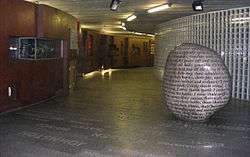Bullaun
- For the village in Ireland see, Bullaun, County Galway
A bullaun (Irish: bullán; from a word cognate with "bowl" and French bol) is the term used for the depression in a stone which is often water filled. Natural rounded boulders or pebbles may sit in the bullaun.[1] The size of the bullaun is highly variable and these hemispherical cups hollowed out of a rock may come as singles or multiples with the same rock.[2][3]
Local folklore often attaches religious or magical significance to bullaun stones, such as the belief that the rainwater collecting in a stone's hollow has healing properties.[4] Ritual use of some bullaun stones continued well into the Christian period and many are found in association with early churches, such as the 'Deer' Stone at Glendalough, County Wicklow.[5] The example at St Brigit's Stone, County Cavan, still has its 'cure' or 'curse' stones. These would be used by turning them whilst praying for or cursing somebody.[1] In May 2012 the second cursing stone to be found in Scotland was discovered on Canna and drawn soon after by archaeological illustrator Thomas Small.[6] It has been dated to c. 800.[7] The first was found on the Shiant Isles.[8] It has been dated to c. 800.[7] The stones were latterly known as 'Butterlumps'.[9]

St. Aid or Áed mac Bricc was Bishop of Killare in 6th-century. At Saint Aid's birth his head had hit a stone, leaving a hole in which collected rainwater that cured all ailments, thus identifying it with the Irish tradition of Bullaun stones.[10]
Bullauns are not unique to Ireland and Scotland, being also found on the Swedish island of Gotland, and in Lithuania and France. Possibly enlarged from already-existing solution-pits caused by rain, bullauns are reminiscent of the cup-marked stones which occur all over Atlantic Europe, and their significance (if not their precise use) must date from Neolithic times.[2]
See also
References
- 1 2 Irish Bullauns
- 1 2 The purpose of Bullauns
- ↑ Pennick, Nigel (1996). Celtic Sacred Landscapes. Thames & Hudson. ISBN 0-500-01666-6. P. 40.
- ↑ Anthony Weir, Early Ireland, A Field Guide, Blackstaff Press, 1980, ISBN 0-85640-212-5
- ↑ Price, Liam (1959-01-01). "Rock-Basins, or 'Bullauns', at Glendalough and Elsewhere". The Journal of the Royal Society of Antiquaries of Ireland. 89 (2): 161–188. JSTOR 25509363.
- ↑ "Keil Stone, Isle of Canna, Small Isles". Archived from the original on 2013-09-27. Small Finds & Design. Retrieved 21 September 2013.
- 1 2 "'Cursing stone' found on Isle of Canna". BBC News. Retrieved 20 May 2012.
- ↑ Scotland in Trust, Prayer Stone. Archaeology. Autumn/Winter
- ↑ Megalithic UK Retrieved : 2013-07-31
- ↑ Isler H, Hasenfratz H, O'Neill T. A sixth-century Irish headache cure and its use in a south German monastery. Cephalalgia. 1996 Dec;16(8): P. 536 - 40.
External links
- Wikibooks:A Researcher's Guide to Local History Terminology A Researcher's Guide to Local History terminology.
- Commentary and video of a Ballaun or rock-cut basins.
| Wikimedia Commons has media related to Bullauns. |